Health Conversations
to get the best value of body, you have to nourish it properly (among other things). The nourishment has two steps before the body gets it. mouth (taste, chewing) and alimentary canal (break it down and transfer to body). Then the body works on it using what it has (hormones, for short). The feeling of hunger is not directly correlated to lack of nutrition and it would be wrong to use it as a sole measure.
The trick is to provide disease free stuff to mouth that it passes to stomach. The content should be so the stomach provides it to body over a period of time. because our lifestyle has changed in last 1000 years and body has not kept pace with it, we should minimize the effects where nutrients are turned into fat or contribute to diabetes and other effects.
- Eat proteins and don't avoid the fat that comes naturally with it.
- Eat non-starchy vegetables, as much as possible.
- Most fruit is not healthy, it's dessert. Only a few things like berries should be added to the diet. Rest of the nutrients will come from the vegetables.
- Have three meals, avoid snacking and drinks in between. If you feel hungry, the good snack are cheese, peanuts, other nut.
- Reduce carbs (sugar, gud, honey, fruit, rice, wheat, corn, potato, oats, millets) to minimum. The less processed, the better. After having carbs, must walk for 10-20 mini within the next hour.
- Think of body as the machine that takes food intake and turns it into life energy.
- understand the chemistry of your body and give proper fuel that is converted to energy over a period of time and is used.
- Avoid the other extreme where too much fuel is converted and then body has to use the fat storage mechanism to store it.
- You are not living in neanderthal life anymore and your body has not yet evolved.
- Body also needs essential minerals and vitamins. You get those mostly from a variety of vegetables.
- BMI = Weight in KG divided by square of height in M. The ideal range is 21 to 25
- It's good to be "addicted" to exercise.
- If you want to control weight, you first need to understand what causes increase or reduction. It's not just calories in vs calories out.
There are many ways of managing weight and avoiding metabolic syndrome. Different strategies work for different people.
- Complete fasting (my mother does this twice a week)
- Intermittent fasting (eg eating only in 8 hour window)
- One meal a day / Two meals a day.
- Very small but more frequent meals.
- Managing composition of diet rather than timing. This is what I follow - Medium carb, high vegetables/protein/fat.
- Keto diets (very low carb, high fat).
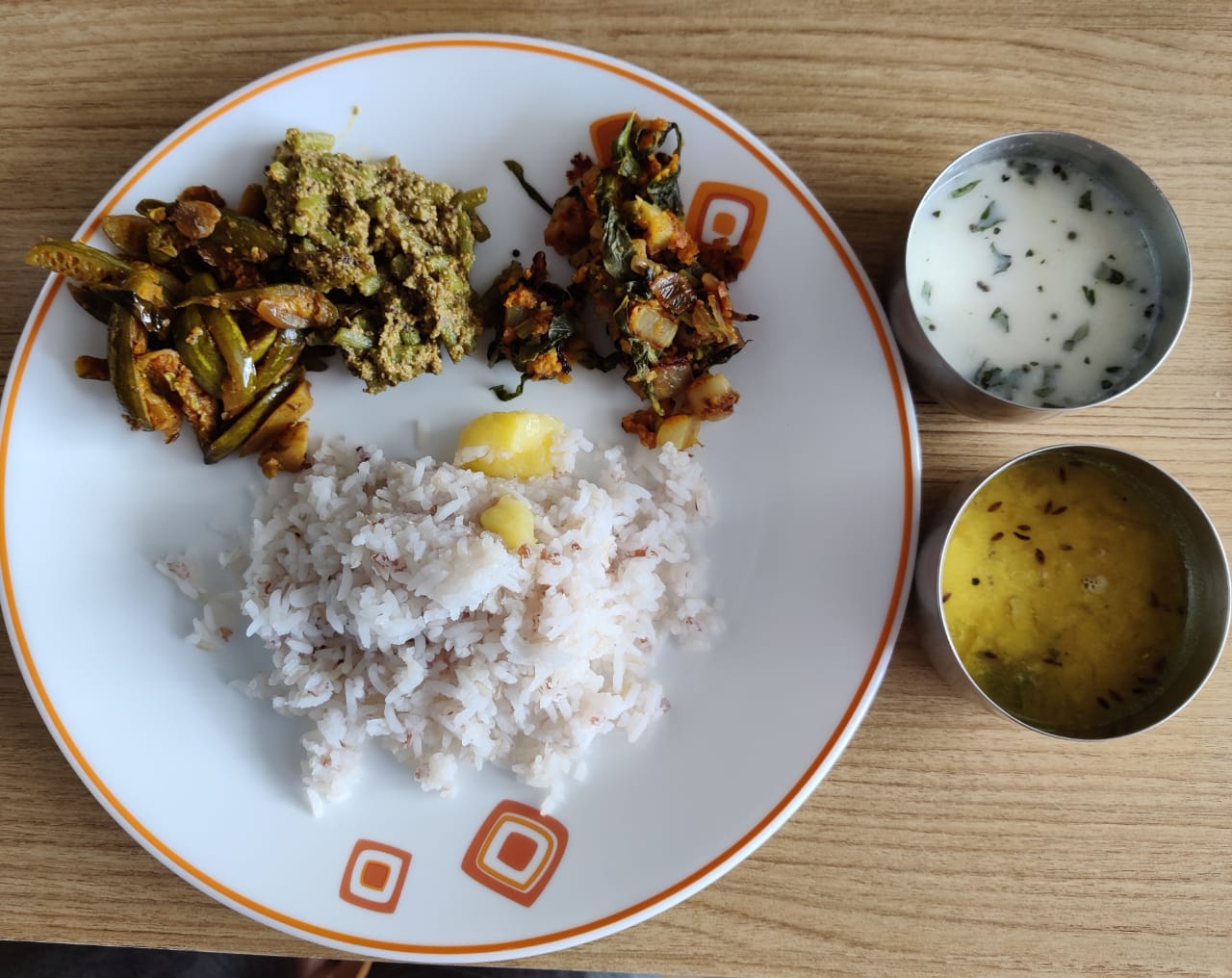
Lunch Rice with ghee. Three vegetables, made with lot of oil. Daal and buttermilk. I did take more helping of daal and sabzis, not rice. Slice of mango as dessert.
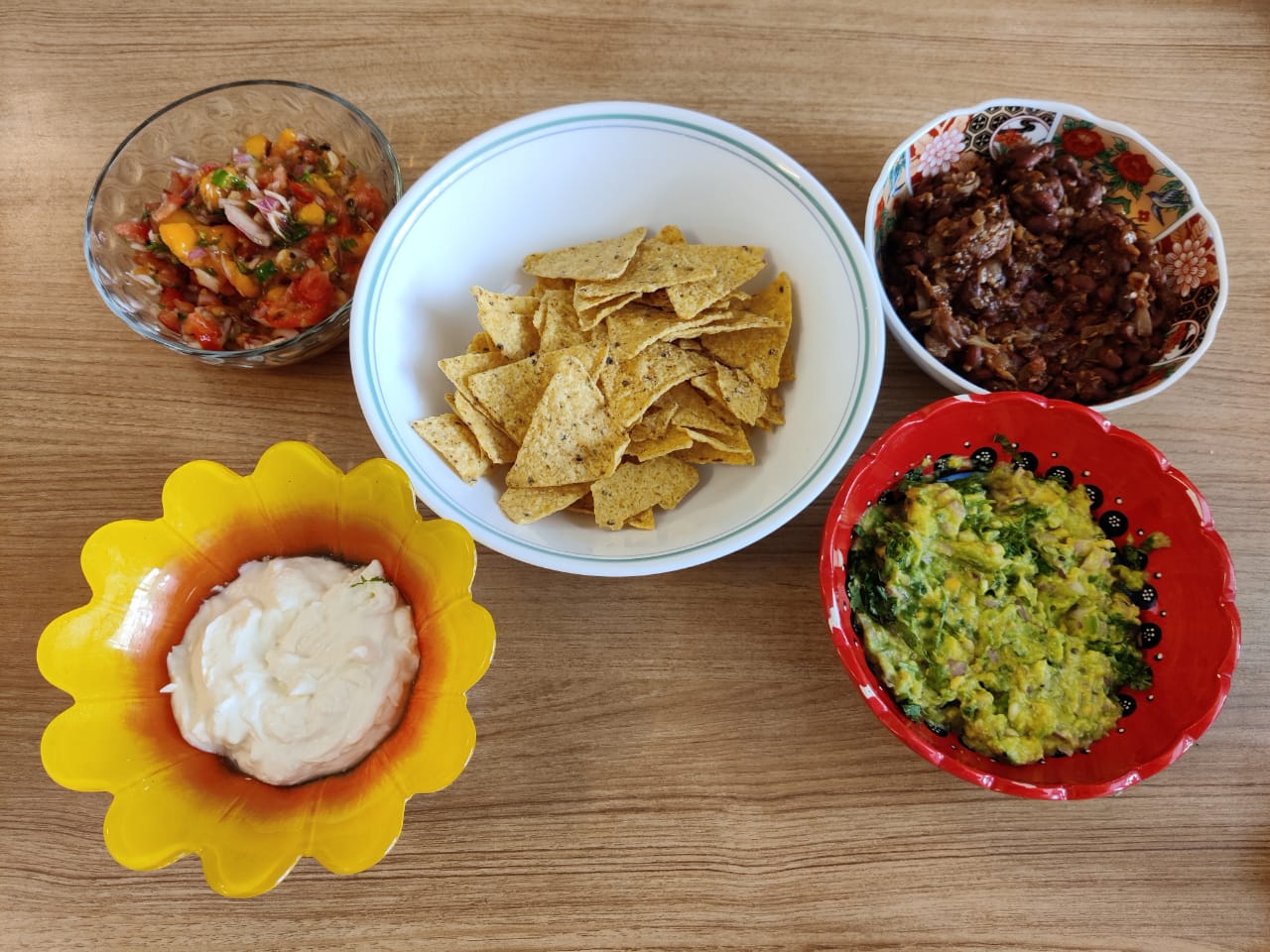
Lunch : four things to go with corn chips. Mango salsa, rajma beans, guacamole and creamy curd. As long as one eats less chips and more of the other things, it's a perfectly healthy meal. Filled with protein, vegetables & fats.
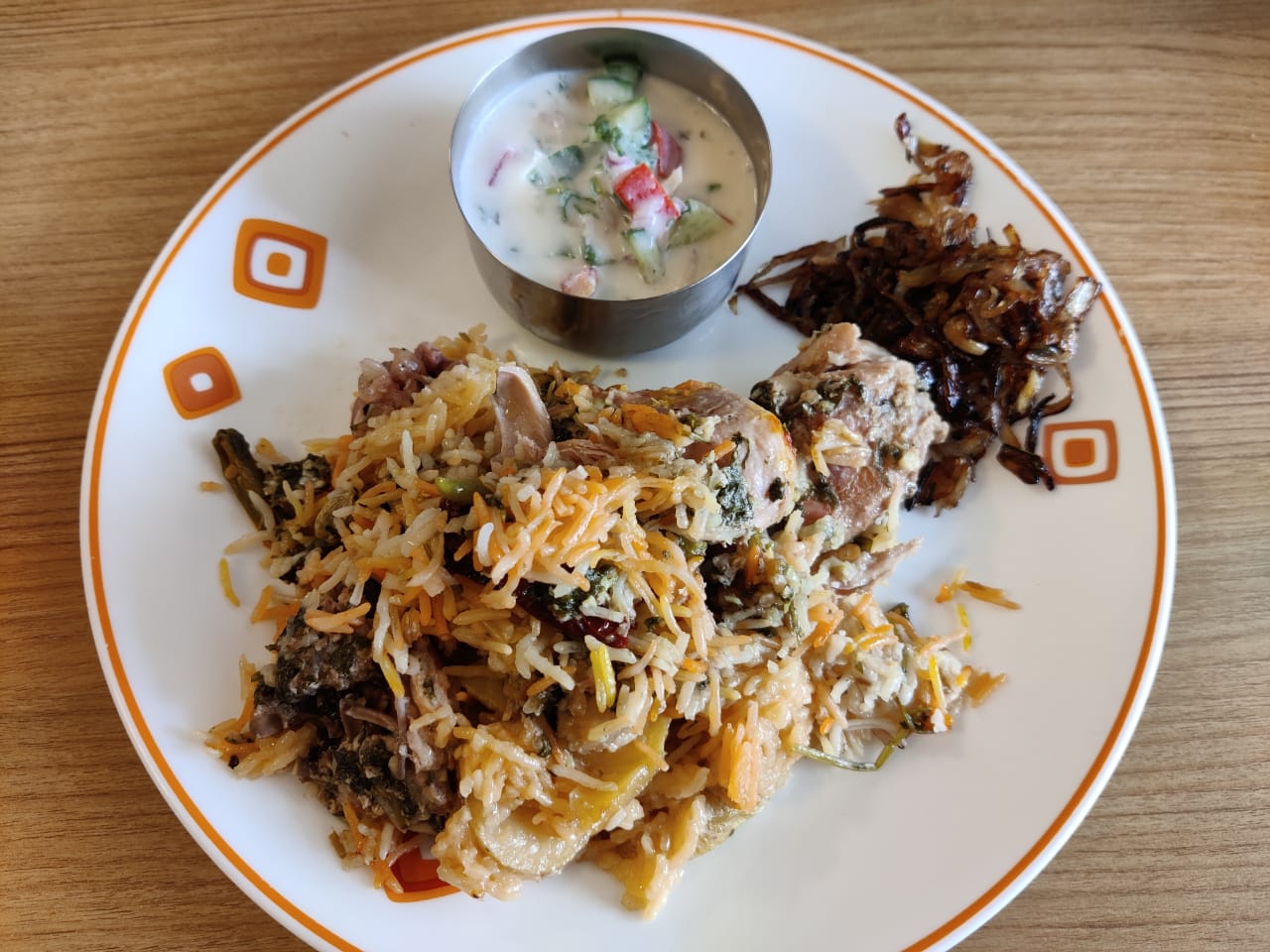
Excellent chicken biryani . Great balance of protein, fat and carbs.
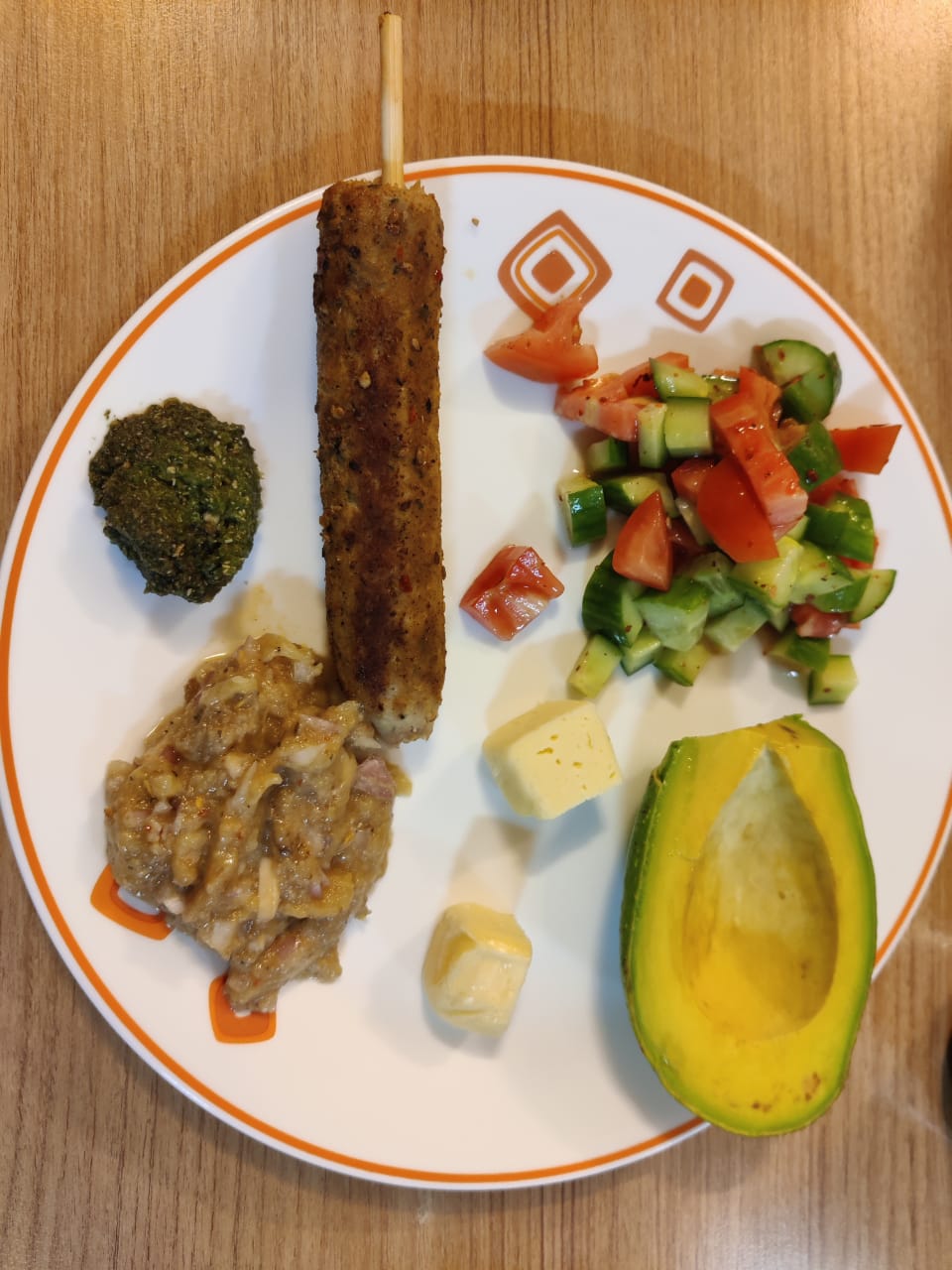
Dinner Seekh kabab, tomato-cucumber salad, avocado, cheese, bengan bharta, pudina chutney. Plus one slice of bread with lot of butter. plus the slice of bread with butter. Later a little fruit as dessert. I felt really full, due to the fat and protein in the diet.
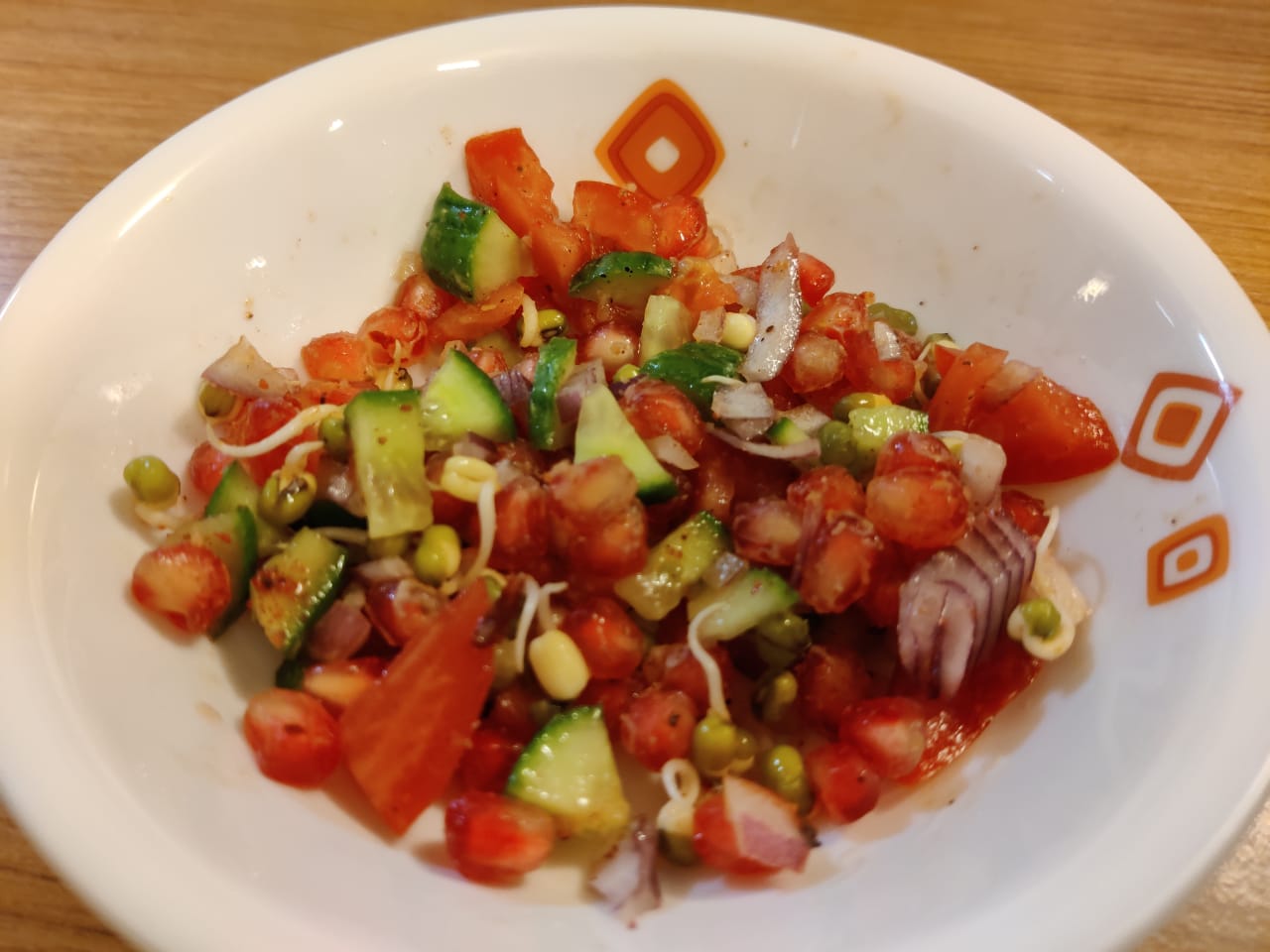
Salad (part of dinner). Tomato, onion, cucumber, pomegranate, sprouts. Salt, chilli, lemon.
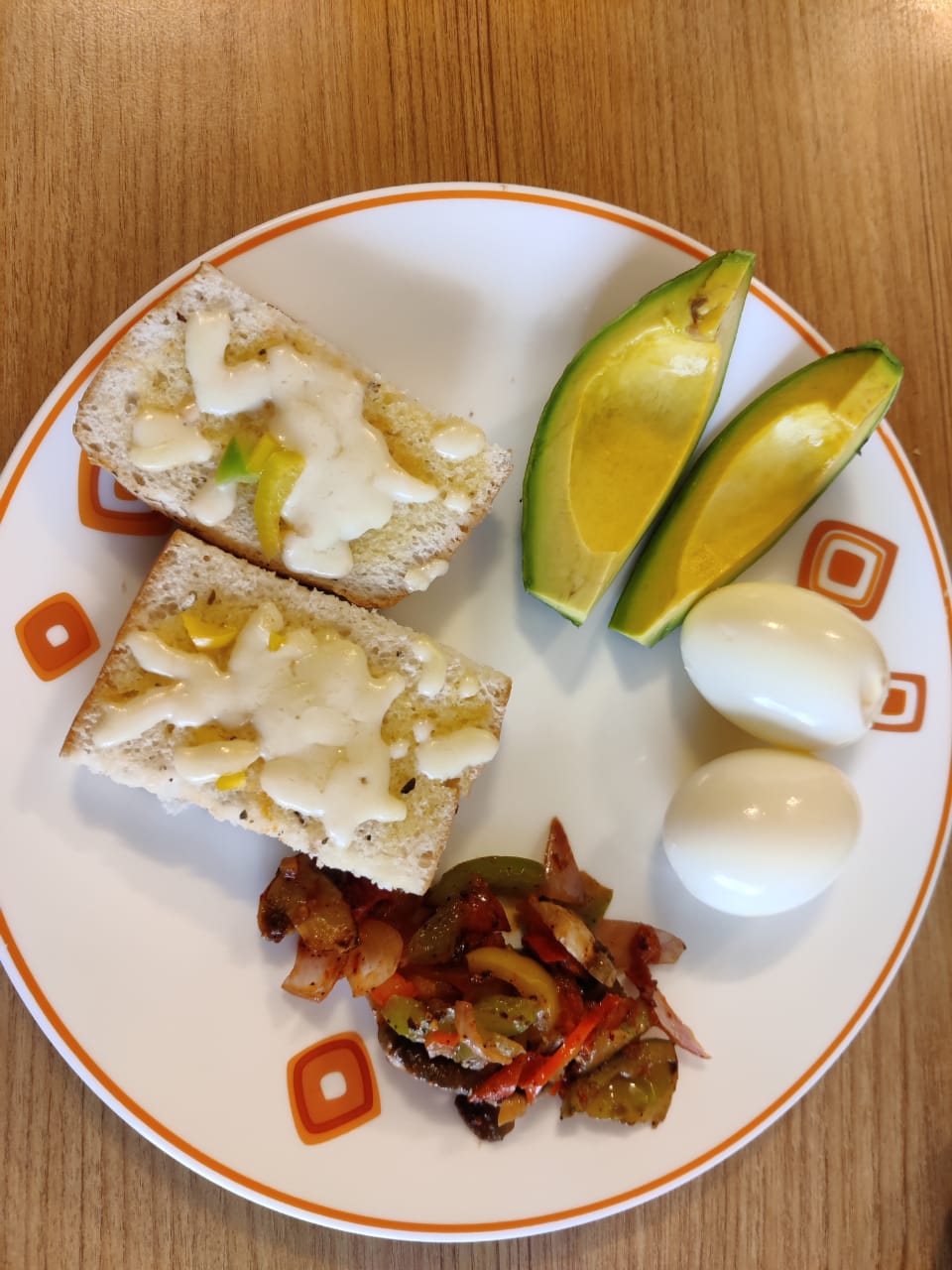
Breakfast: Panini bread toasted with butter and cheese, avocado slices, boiled eggs, Sauted capsicum and mushrooms. Followed by coffee. Also a cup of milk and small banana before morning walk
- You can use olive oil. Basically any clear oil with little or no smell.
- People who like the flavour can even use coconut oil or mustard oil.
- Milind does not subscribe to theory that olive oil is good and vegetable oil is bad.
- Some reasearch says animal fat (from milk / fish / chicken etc ) is good.
- Some says olive oil is good.
- Some fats contain omega 3 (eg fish oil), and some contain omega 6. Body needs both so a balance is important.
- It's unanimously agreed that hydrogenated fat / Trans Fat (Dalda type) is bad. That is used in many snacks to enhance taste. Avoid those by reading the label.
- Getting fat from real food like nuts, cheese and eggs is best.
- After that any oil is the same.
- Each gram of oil gives you about 9 calories. Each gram or carb/protein gives 4 calories.
- So each gram of oil/fat allows you to reduce carb consumption by at least two grams (in reality even more because oil will make you feel full).
- Oil does not spike up the insulin in your blood. Protein gives a medium spike. Carbs give a big spike
- Fat has been wrongly demonised due to poor research in the 60's.
- Several nations like France have high fat diet and low incidence of heart problems.
- Same weight of Bread pakoda is better than plain bread, because you get oil and some protein from besan.
- Similarly paratha is better than chapati.
- Sugar rush inevitably results in sugar low after some time. And increased weight / diabetes over time.
- When the body keeps getting lot of glucose (sugar/starch), then too often the body has to produce lot of insulin. After some time the cells become immune to insulin and refuse to accept glucose even when insulin is present. This is type 2 diabetes.
- The early indicator of diabetes is high level of insulin in the blood when one has eaten nothing for 9-10 hours. Hence the fasting insulin test is recommended once a year.
- Doctors usually don't prescribe "Fasting Insulin" test. This is the only lead indicator (होने वाला है or forward looking, what may happen.) of diabetes. The tests that they prescribe (fasting glucose / Post Prandial glucose / HBA1C) are all lagging (हो गया है after the fact, what do we do now) indicators.
- So if you have the option to get the fasting insulin test done at your own cost, please do it once a year.
- High level of insulin keeps the weight high and doesn't allow fat to be converted into energy. That is why one feels the "need for sugar".
- It's a vicious cycle.
- So, the trick to more energy and less weight is lower insulin level. How does one achieve that ?
- What we are trying to avoid is insulin resistance.
- If the body doesn't respond to small amount of insulin, the pancreas has to produce more.
- After some time, even this higher level of insulin becomes ineffective, that is when sugar starts rising.
- In the journey of a diabetic the insulin level rises first ( undetected for several years) and then sugar rises and the person becomes diabetic (even that may be undetected for few years).
- This is why fasting insulin is the leading indicator.
| Butter | Simple unsalted butter is the easiest fat to eat. Anything added to that will make it suspect. |
|---|---|
| Salad | Cucumber, tomato, grated carrots, watermelon seeds, oil (nutrition and taste), salt, vinegar (taste), black pepper powder. Add any oil, sprinkle salt and squeeze some lemon. It will suddenly taste much better. |
| Travel | it is even more important to maintain reduced carb diet. Most probably you will be eating out or ordering room service. Don't bother about finishing the portions, if there are huge sides of fries or rice. |
| Seeds | You can buy seeds at any supermarket food section. watermelon / pumpkin / sunflower seeds. Or just buy roasted almonds or plain walnuts kernels. |
| Banana | When I do intense and long exercise (10+ km run / 30+ km cycling), the body needs ready supply of carbs. That is where banana is very useful. It also provides minerals like potassium. In general, having some carbs before a long exercise session is good idea. Provided the exercise is long enough to burn those calories and more. |
| Cheese | I like cheddar cheese. You should buy small packa of 3-4 varieties and decide what you like. Eating a chunk or cube is the easiest. But no harm grating it on salad etc. |
|---|---|
| Milk |
|
| Sprout |
|
- We need to discuss Triglycerides
- Human beings have evolved to overcome cycles of plenty and famine.
- During good season (spring / summer) plenty of fruit and starchy food was available, and it was tasty. As soon as one eats carbs (sugar, glucose, fructose, starch from wheat/rice/millets/potato etc) ...it mostly converts to Glucose and fructose and sugar level in the blood goes up. Insulin helps glucose get into the cells.
- If the person is doing physical work, this glucose will burn to provide energy. If not, it will get stored. First level of store is glycogen which is stored in muscles and liver. The body can store upto 2000 calories in the form of glycogen. After this glucose starts getting converted to fat and stored in cells.
- When human beings went through famine (winter / bad weath…
- Body was designed as battery to save energy but now there is external battery and this feature of human body is not needed.
- So all the extra fat stored in our body is for those bad times.
- Fasting - artificially create bad times. My mother lost 18 kg over 6 years by fasting two days a week. She would have only two cups of tea and several glasses of water. She was diabetic and now normal. However this requires enormous will power.
- Extra exercise without changing the diet. It's difficult to do because exercise also causes hunger.
- Changing the composition of your diet.
- Sweet fruits, sugars, sugary drinks etc.
- Starchy carbs - rice, wheat, potato, oats, millets etc.
- Carbs + proteins + some fat : Milk (and paneer/dahi/cheese etc), daal etc.
- Proteins plus fat : Eggs, nuts, mutton, chicken, fish etc.
- Fats : Ghee, butter , oils .
- Carbs
- Proteins
- Fats
- Low carb veg with fiber.
- Different foods make you feel sated or hungry at different rate.
- Carbs go in, get ingested quickly (finely ground and cooked carbs even faster - hence maida is worse than aata or daliya). They give a glucose high and after a few hours a glucose low which makes you feel hungry again. Please note, it's not that your body doesn't have enough calories at this time. It's just the way the chemical reaction works. The excess carbs consumed in the process get deposited as fat.
- On the other hand protein and fat get ingested more slowly. As a result you feel full much longer. It's possible to have just one meal a day. In fact that is a well established diet pattern.
- sautee means shallow fry. It's kind of half cooking the vegetables to make them softer, easier to chew and digest. Plus it adds good calories from oil that will keep you feeling full. In India we tend to avoid eating raw greens because they may have parasite eggs etc. I don't think that is an issue in the US due to cleaner agriculture practices. So if you like raw spinach, have it. Capsicum can be eaten raw of sauteed or cooked.
- If carbs are reduced, what is the substitute? Keeping hungry is not long term feasible solution.
- Less oil is the problem. Created by outdated facts 😀
- I used to eat two chapati per meal. I reduced it to one chapati (no rice) but increased two spoons of ghee in each meal. Also increased consumption of vegetables. The result was 4 kg weight reduction in one year.
- reduced from three chapati per meal to two and usually have only two chapati on most days (one meal), more vegetable. We put ghee on roti now but not two spoons. she has started putting extra ghee on roti, daal and all.
- Take it further in the same direction.
- If I look at your diet chart the following are carbs :
- Banana, kheer, rice, roti, bread, milkshake, poha, crackers.
- Nuts - almonds, peanuts, pista etc.
- Cheese cubes (if you like the taste)
- Salad (you can schedule a salad break during work)
- Coffee with cream, but low on sugar - again works well as a scheduled break at office
- Boiled or fried eggs - ideal for late night pangs.
- At breakfast I can easily have 20g of butter with two egg Omelette. Just one slice bread.
- Poha was a favourite breakfast earlier, now rarely have that.
- Salad is a good option to fill the stomach. Chopped tomatoes, cucumber, salad leaves, nuts, fat and salt/vinegar/lemon.
- Another alternative is Sauted vegetables because you can have more fat with that.
- eating banana when hungry is worse than eating sauted vegetable and fat is not poison. is that what it implies?
- Fat will make you thin and energetic.
- A vegetarian south Indian friend was in trouble due to the usual carby diet. His doctor told him to cut rice/idli/dosa and increase consumption of Vada/coconut chutney/oily subzy/sambhar. It has worked very well for him.
- Vegetables are good. Fruit is almost evil.
- Most fruit today is engineered over centuries for more and more carb.
- The only thing worse than fruit is - fruit juice.
- Identify all carbs in your diet
- Gradually reduce them and increase vegetables, fats, proteins. In that order.
- Can you come up with three things you can change in your meal pattern ?
- I don't insist on mon veg. There are equally good veg options.
- quinoa is not a low-carb food. A cup of cooked quinoa has more than 39 grams of carbohydrates. That’s 50% more than in the same amount of brown rice and almost as many carbs as in white rice.
- This is your own personal journey. Each person finds a set of things which work for him. I'm not a doctor or exercise coach or nutritionist. I'm only supplying information about what I've read and what had worked for me or some people I know.
- Make one change at a time. Note down the change and observe for 2-4 weeks. Note the positive and negative effects you see. Then discuss and decide the next move. No sudden, frequent or drastic changes.
- Regular medical tests (like fasting insulin / Lipid profile / TSH) to keep track of things.
- Keep your doctor informed. If he raises any concerns, research and address those.
- Over a year or two you will settle into what works best for you.
- you will have to substitute that missing roti/chawal with something else (fat & vegetables & daal). This will give you longer slow release energy.
- Don't try to just go hungry.
- About salads - you can use tomato, cucumber, onion, mooli, gajar, green salad leaves, boiled beans etc etc. To make it more interesting, add nuts and seeds. Pour oil on top, add vinegar or lemon juice for taste. You can also add black pepper, little chilly powder and salt.
- You can also add a little fruit to th salad to make it interesting. Chopped strawberry, orange, blueberry or cranberry give a nice taste.
- Grated or chopped cheese is alao a good value addition.
- You should be able to get readymade salads in your supermarket too.
- In your breakfast - toast, bread, cereals are carbs and milk is half carb.
- So careful with the quantity of these.
- Egg, butter, avocado is great
- All bread is the same. It's carbs
- Like any other bread, it is 40-50% carbs (including added sugar)
- Diet change is more important than exercise. Even if you miss exercise for a day or two, the damage is limited. If you go off diet discipline, the damage is much more.
- Fruit is also carbs. So you just replaced one carb with another.
- Most Fruit ( especially any fruit that tasted sweet), all cereals, wheat, rice, grains, potato etc are carbs. So straberry is carb heavy but cucumber is not.
- strawberry is better than rice/roti/ Maggi because it has much higher water content that makes you feel "full"
- Mixed nuts I bought from costco are good.
- Granola from Costco has heavy loads of carb, unhealthy
- More carbs leads to lethargy.
- If carbs are ground fine (eg Maida) they are much easier for the stomach to convert to sugar. Those are worse than unprocessed carbs (eg boiled or roasted corn) But eventually all carbs add to weight.
| Type | Break | Granola |
|---|---|---|
| Caolries | 120 | 270 |
| Total Fat | 2.5g | 7g |
| Saturated Fat | .5g | 1g |
| Trans Fat | 0g | 0g |
| Polyunsaturated Fat | 1g | 3g |
| Monounsaturated Fat | 1g | 2mg |
| Cholestrol | 0mg | 0mg |
| Sodium | 150mg | 35mg |
| Total Carbohydrate | 20g | 51g |
| Dietary Fiber | 3g | 7g |
| Total Sugar | 8g | 16g |
| Includes Added Sugar | 4g | 9g |
| Protein | 5g | 7g |
| Vitamin D | 0mcg | 0mcg |
| Calcium | 40mg | 60mg |
| Iron | 1.2mg | 1.7mg |
| Potassium | 110mg | 230mg |
| Thiamin | 0.14mg | |
| Ribofavin | 0.07mg | |
| Niacin | 1.3mg | |
| Folate | 10mcg | |
| (0mcg folic acid) |